This was published 5 years ago
'I wanted to allow for some accidents': Renee Zellweger's time out from fame
After bursting onto the Hollywood scene in the late 1990s, Renée Zellweger emerged as a genuine star. Then the pressure of fame took its toll – which makes her the perfect person to play a struggling icon: Judy Garland.
By Jonathan Van Meter
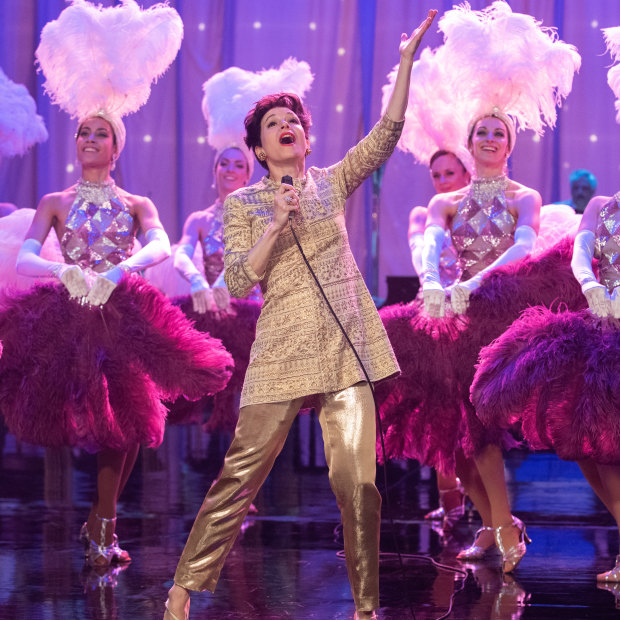
Renée Zellweger as Judy Garland, whose schedule, she says, meant Garland was “not allowed to be human … She was exploited and … robbed, basically.”Credit: NBCUniversal
It's a wildfire-hot August afternoon in Topanga Canyon, California, the air so dry and still you can practically hear the sagebrush gathering itself for the conflagration. Everyone’s gulping down great lashings of water, including Renée Zellweger, who can’t hydrate fast enough. We’ve been hanging out now for nearly two hours on the patio of Topanga Living, a little cafe that’s one of Zellweger’s regular joints. As she heads inside for more supplies – bottles of turmeric juice, tea and more fancy water – a young dude a couple of tables away leans over.
“I don’t mean to make this weird,” he says, “but is that Renée Zellweger?”
The actress, meanwhile, has stopped to talk to a lesbian couple with a tiny dog sitting near the door. They are earnest in the extreme and seem not the least bit starstruck, which makes me think they have no idea who she is; just some nice lady in capri tights and running shoes with a voluminous scarf draped around her neck. When Zellweger gets back to our table, I express surprise that the couple didn’t get movie-star dopey, and she says, “Nope.” A big smile spreads across her face. “I have very authentic exchanges with people once again.” She stares at me for a second and then screws up one of those great Renée Zellweger faces.
“Thankyouverymuch,” she says, sort of doing Elvis if he were from Texas. “Six years. It was important, that time. You’re not in people’s consciousness anymore, so they don’t immediately make the connection. It’s a quieter life, and I love it.”
For a long time, Zellweger had anything but a quiet life. You could blame 1996’s Jerry Maguire, which took her from ingénue to star. Or maybe the Bridget Jones movies of the early 2000s, which further solidified her image as a relatable Everywoman but which also turned her into tabloid prey right at the moment when newsstands began to look like Warhol installations, giant chequerboards of the same woman on the cover of every magazine, from Us and InTouch to Vogue and Elle. Who could look away from a star gaining and losing weight for a role in plain sight?
Zellweger dated rock stars and movie stars and was a genuinely fascinating creature of that last great Hollywood moment before it all became one big, smelly sweat-sock of adolescent-boy entertainment. She was effortlessly soignée on the red carpet, the darling of fashion editors. And she was a star for Harvey Weinstein’s Miramax: her three Oscar nominations came for films (Bridget Jones’s Diary, Chicago and Cold Mountain) that he had produced. It was an era that, in some ways, couldn’t have been crueller to actresses, but also one that allowed them to play challenging parts in prestige films. Zellweger, perhaps, experienced the highs and the lows as acutely as anyone.
And then, in 2010, after a series of duds and ill-conceived roles, she stepped off the merry-go-round: stopped making movies, wearing daring dresses to premieres, doing big interviews. She briefly came out of hiding in 2014 to attend the Elle Women in Hollywood Awards, and the press focused almost entirely on what the internet presumed was plastic surgery that had rendered her unfamiliar-looking. She handled it with grace and eventually wrote an essay for HuffPost, criticising the media scrutiny, called “We Can Do Better".
In 2016 she eased back into movies, including Bridget Jones’s Baby, and has been quietly, steadily working ever since. This month, the film Zellweger has chosen for a proper comeback, Judy (as in Garland – a biopic), came out in the US, and next month it will be released in Australia. It is a brave decision on so many levels – the challenge of singing like Garland, of playing a woman who, at 46, looked much older – not least because the ways Garland struggled with loneliness, insomnia and the tolls of show business in general resonate with some of Zellweger’s own struggles, even if hers are not remotely as volcanic as Garland’s were.
Stepping back, Zellweger says, was crucial. “I wasn’t healthy. I wasn’t taking care of myself. I was the last thing on my list of priorities.” She has seen a therapist during only one period of her life, she tells me, and it was back then, as she retreated from acting. “He recognised that I spent 99 per cent of my life as the public persona and just a microscopic crumb of a fraction in my real life. I needed to not have something to do all the time, to not know what I’m going to be doing for the next two years in advance. I wanted to allow for some accidents. There had to be some quiet for the ideas to slip in.”
When it gets to be too much, when you learn that your skin is not quite as thick as you need it to be, what is that gonna feel like? Well, now I know. I got the hardest kick. And it ain’t the end.
Renee Zellweger
One day around this time, she ran into her friend Salma Hayek in an airport. “She shared this beautiful … metaphor? Analogy? ‘The rose doesn’t bloom all year … unless it’s plastic.’ ” She levels me with a look. “I got it. Because what does that mean? It means that you have to fake that you’re okay to go and do this next thing. And you probably need to stop right now, but this creative opportunity is so exciting and it’s once-in-a-lifetime and you will regret not doing it. But actually, no, you should collect yourself and, you know … rest.”
Thanks to the shrink, she realised she was depressed. “Nothing like international humiliation to set your perspective right!” she says with a mordant laugh. “It clarifies what’s important to you. And it shakes off any sort of clingy superficiality … that you didn’t have time for anyway. One of the fears that maybe, as artists, we all share – because we have this public experience of being criticised not just for our work but as human beings – is when it gets to be too much, when you learn that your skin is not quite as thick as you need it to be, what is that gonna feel like? Well, now I know. I got the hardest kick. And it ain’t the end.”
But she also wants to be perfectly clear: the rough patch only lasted a year. “I had a good five-year period when I was joyful and in a new chapter that no one was even aware of.”
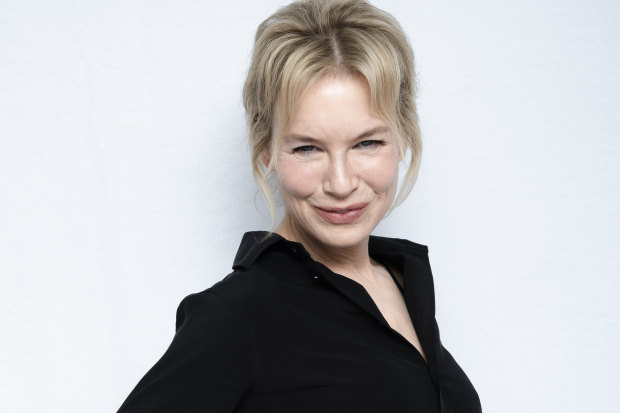
Renée Zellweger reminiscing on her earlier Hollywood days: “None of it I regret. Though a lot of it? No, thank you.”Credit: Armando Gallo/ZUMA Studio/Tribune News Service
Renée Zellweger hadn’t planned on any of this. She was an English major at the University of Texas at Austin in the early 1990s. She thought that she was going to be a writer, maybe a journalist, but an acting class in her junior year led to a role in a student’s thesis film based on a Flannery O’Connor short story, in which she played a girl full of wanderlust who winds up in a boarding house contemplating suicide.
“There was this scene on the bathroom floor where she’s in such deep despair,” she told me when I first wrote about her years ago. “And as we filmed it, I was just dumbfounded. It was so much more than I had expected it could be, and I didn’t know where it was coming from or why it was so important to me to return to that bathroom and do it again. From that point, I didn’t care where it was going, I just knew I wanted to do that.” Before long, she was the “Girl in Blue Truck” in Dazed and Confused, then did Texas Chainsaw Massacre: The Next Generation, both starring Matthew McConaughey, who remains a good friend (she does a pitch-perfect imitation of him). She had memorable turns in Reality Bites and Empire Records – Gen-X indie classics – but she really blasted off when she co-starred with Tom Cruise in Jerry Maguire.
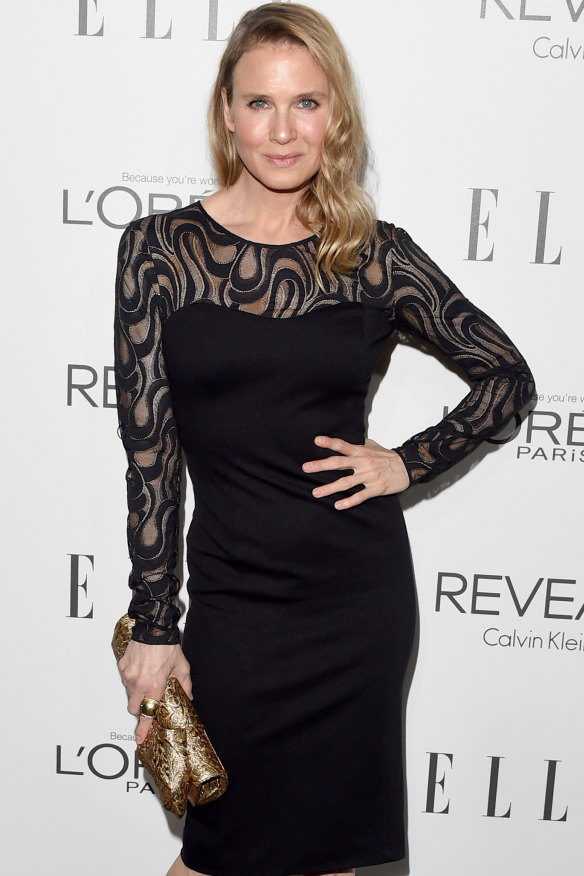
On the red carpet in 2014.Credit: Getty Images
Right out of the gate, she got saddled with one of the most indelible lines in modern cinema: “You had me at hello.” It’s hard to over-estimate the deleterious effect this sort of thing can have on an actor. It gives strangers permission to invade your boundaries everywhere you go; they shout it at you in airports and hotel lobbies. And then, in quick succession, she made a bunch of interesting comedies: the underrated Nurse Betty (for which she won her first Golden Globe), Me, Myself & Irene, and Bridget Jones’s Diary.
Jones is officially a classic, pure Zellweger goofball magic. She is so identified with the role that there’s an entire generation of women who assume she is a clumsy, befuddled mess with food on her sweater. After that came the Oscar juggernaut Chicago, which led to her second nomination and the semi-comedic role of Ruby in the 2003 US Civil War drama Cold Mountain, for which she won the Oscar for Best Supporting Actress. But that was followed by another Bridget Jones, then a string of films you’ve probably never heard of, and her retreat – just as she was entering those years in which Hollywood doesn’t quite know what to do with actresses whose talent they don’t entirely understand.
“None of it I regret,” Zellweger says. “Though a lot of it? No, thank you.” She lets out a honking laugh. “If I could remember more of it, that would be nice, because my 30s are a blur. I think I just didn’t sit still long enough to actually let anything soak in. People are like, ‘Remember that time we …?’ and I have absolutely no recall about the thing at all. What’s my girlfriend say? The file cabinet is bound to get full at some point, and something’s got to fall out the back.”
We talk for a moment about how she gets nervous for young actresses who are obviously going from film set to film set and look slightly unhinged on the red carpet – with barely masked terror in their eyes. “You can see how vulnerable they are,” she says. “When you’re not grounded, how can you have boundaries?” You can’t just grind on forever, I say. “Well, you can,” she replies. “But then you’re really unhealthy and unbalanced and, you know, about to die. And then you look back on it and wonder what happened. And where are the relationships that you didn’t have a chance to nurture?”
She continues: “I had lots of different places to live but no home. No home where I actually unpacked pictures and put them on the shelf … I had two suitcases. I knew where my passport was, I knew where my important papers were – the inoculations, all that stuff, were in my carry-on, all the time. Now I put the carry-on up on a shelf!” Here she lets rip with another one of those patented laughs – full-throated, head back – and everyone on the patio looks over and realises who she is.
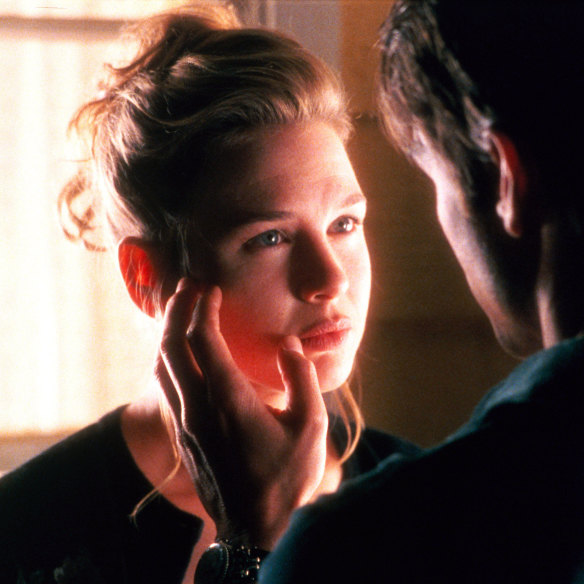
In 1996's Jerry Maguire. Credit: Alamy
I first met Zellweger during this peripatetic period in her life: on a soundstage in Toronto in February 2002 for Chicago. I was writing a piece about the making of that film, but Zellweger avoided everyone when she wasn’t in a scene, including me; it was the first film, I would later learn, where she’d figured out that it was just easier if she kept to herself and stayed in character all day. I would see her going in and out of her trailer, in Uggs and a puffy coat, so thin, clutching a cup of tea, hugging herself against the cold, being cheerful and unfailingly polite but never stopping long enough to truly engage. She was a blur.
Catherine Zeta-Jones, Zellweger and I would eventually all have dinner in Manhattan a couple of months later. Zeta-Jones showed up late in a leather trench coat and a cloud of perfume and ordered a rare steak and champagne. Zellweger arrived very early – in her running clothes – and ate steamed spinach.
A year and a half later, as I was writing a profile of Zellweger for the release of Cold Mountain, I met her one July afternoon at New York’s Mercer Hotel, and she kept me waiting in the lobby for nearly an hour. She was dating singer-songwriter Jack White at the time and admitted to me that she’d been up all night with him and some friends in their suite. I remember thinking: Is she on drugs? It just didn’t make sense, given the clean-machine approach, the constant running, the healthy eating. Was she in love? “Don’t know,” she said. “Don’t ask myself, don’t talk about.”
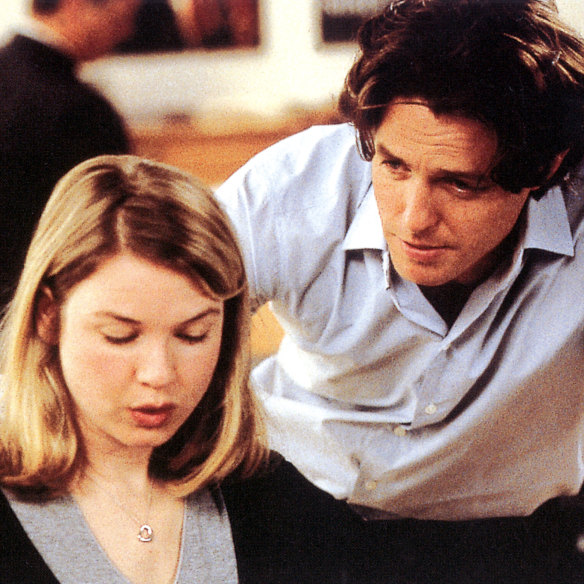
Bridget Jones’s Diary with Hugh Grant, 2001 - "pure Zellweger goofball magic".Credit: Alamy
A week later, I was on a plane to London, where Zellweger was preparing to play Bridget Jones once again. She had the flu and was wrapped in a blanket, clinging to a cup of tea as if her life depended on it. Despite the illness, she was hilarious and smart, and we talked for hours in a dark hotel-lobby bar. She was gaining weight to play Jones, and her assistant kept bringing her little bowls of food every half-hour: potato chips mostly, but also doughnuts.
Back then, she couldn’t stop buying up old houses. There was the townhouse on the Upper East Side, the big pile on the East End of Long Island. She was searching, she tells me now.
“I did a where-are-you-supposed-to-live tour around 2003. I started in New York City and I had just a toothbrush in my purse and drove all the way out to the Cape.” She stopped along the way in towns in Connecticut and New York and Massachusetts, eventually buying a farm in the very far-northwestern corner of Connecticut, in the same town where her brother Drew, to whom she is exceptionally close, had moved with his wife and two kids.
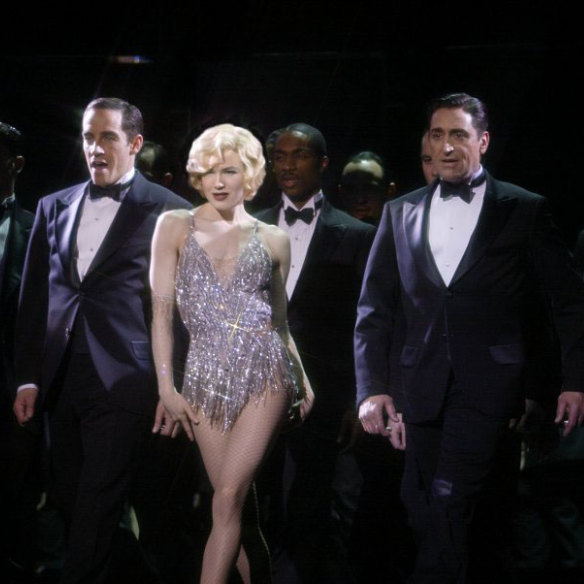
Chicago (2002) led to her second Oscar nomination.
It must be said: Zellweger looks great; she looks like herself again. Whatever was going on that night on the red carpet a few years ago that made everyone think she had radically altered her trademark – her eyes, which are practically her calling card, so crinkly and comically expressive – was obviously temporary, because she looks, well, like Renée Zellweger at 50. But Hollywood 50, which is to say, several years younger.
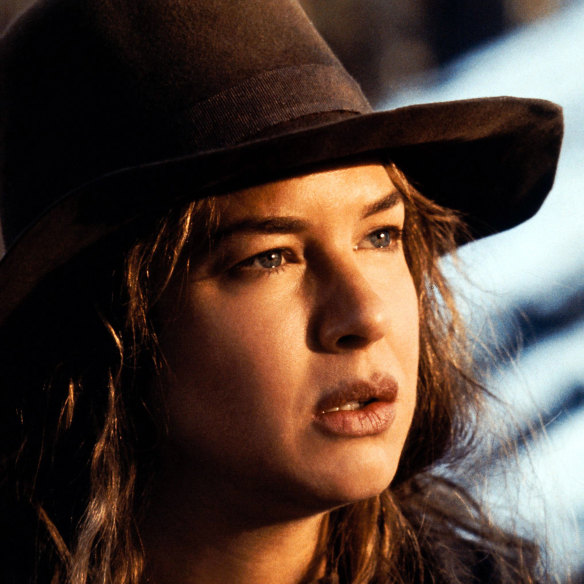
Cold Mountain (2003) earned Zellwegger her first Oscar, for best supporting actress.
When I tell her I am a little reluctant to bring up the “whole plastic-surgery kerfuffle”, she says: “Because it probably gives you a stomachache, asking me about that, doesn’t it?” There is a long pause. It’s a difficult topic, I say. “Well, because there’s a value judgment that’s placed on us,” she says.
“As if it somehow is a reflection of your character – whether you’re a good person or a weak person or an authentic person.” I suggest to her that there was a kind of panic people felt that she somehow did not look like herself.
“And the implication that I somehow needed to change what was going on because it wasn’t working,” she continues. “That makes me sad. I don’t look at beauty in that way. And I don’t think of myself in that way. I like my weird quirkiness, my off-kilter mix of things. It enables me to do what I do. I don’t want to be something else. I got hired in my blue jeans and cowboy boots with my messy hair. I started working like that. I didn’t have to change to work. So why was I suddenly trying to fit into some mould that didn’t belong to me?”
During those years she wasn’t making movies, Zellweger created and produced a TV series – Cinnamon Girl, about four young women, musicians and artists, coming of age in Los Angeles in the late 1960s – that did not get picked up. She travelled a lot, to places like Thailand and Liberia, which she visited with a friend from London who had started an organisation that recognises leaders who advocate for women’s rights, in this case the west African country’s president, Ellen Johnson Sirleaf.
She also went back to school, taking classes at a university in Los Angeles that she’d rather not name because she’s planning to continue: “I was just interested in learning a little bit more about international policy, getting a little smarter about it all, to see if it was something I had an aptitude for away from the news on the television set. It was fantastic.”
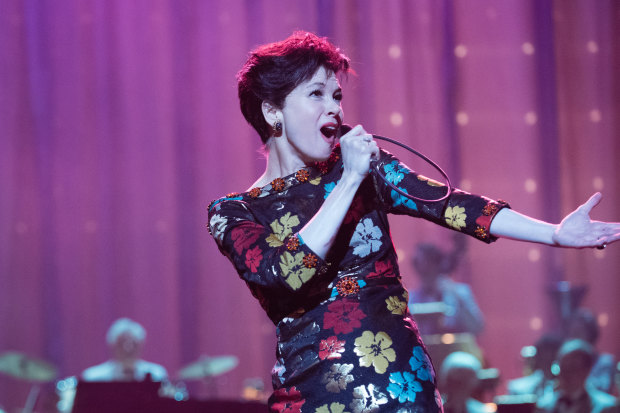
Renée Zellweger as Judy Garland in this year's biopic, Judy.Credit: NBCUniversal
Judy, an adaptation of the Tony-nominated musical drama End of the Rainbow, is set in 1968, as Garland arrives in London for a five-week run of sold-out shows at the Talk of the Town nightclub – where, predictably, she succumbed to booze and pills and some nights couldn’t perform, unless, of course, she was on and blew the roof off the place. The movie, which debuted at the Telluride Film Festival in late August, is directed by Rupert Goold, best known for staging Shakespeare as artistic director of the Almeida Theatre in London.
The film is good, not great – though it hardly matters because Zellweger is riveting as Garland, her best acting to date. She plays her as a spooked mess, both studied and utterly free, so intense you barely notice some of the more lachrymose Wizard of Oz flashbacks. She nails the way Garland, arms akimbo, hunched herself and chewed on her words: IsFrankSinatrahere? She ties herself into a pretzel, suffering alone in a hotel bathroom in the middle of the night, zonked on pills yet still unable to sleep. Zellweger even manages to conjure Garland’s butch aspect – “I’m fine!” – and that slacks-and-a-blouse march in kitten heels down the long hallway that leads to the stage on opening night.
I ask Zellweger how she approached playing Garland, and she answers with one word: “Denial” (a snappy retort right out of the Garland playbook). “I felt like we never actually did it. We were talking about seeing what we might be able to do. Every day. Just try that. Try and see what this feels like and what does that hair colour look like, let’s try this kind of make-up and then let’s try these songs, with this kind of orchestration. Let’s try to emulate this year and this less successful evening in her life,” she says. “A lot of it was, like, dentist rage. You know that dentist rage? Where you don’t have a choice? You. Just. Have. To. Do. It.” She bangs her fist on the table between each word. “And then you’re so glad that you did? That’s what it was like.”
“It’s a big ask to play Judy Garland,” says Goold. “The Scandinavian-looking, blonde, diminutive Bridget Jones wasn’t necessarily slam-dunk obvious.” But when she came to London for a meeting in 2017, he was “just so taken by how bright she is”. They spent three days around the piano at Abbey Road studios, “just feeling each other out, singing together. She’s got a really good voice and a really good ear – great pitch, great phrasing. And I thought, ‘She’s got a long journey to travel, obviously, but this is a colleague I really want to work with.’ Yes, she needs to be able to sing, but that wit, that spiky intelligence, is No. 2. When you watch that old Garland footage from talk-show interviews – she’s brilliant. Just when you think she’s maybe spiralling away, she snaps back – really crisp and laser-like.”
Judy costume designer Jany Temime, best known for the Harry Potter films, says, “Renée was extremely emotionally and artistically involved in Judy. It was her film. I think she really got into Judy’s skin.”
As close to literally as possible: says Zellweger, “Jany fit the costumes to Judy’s posture. So the dresses didn’t fit me unless I stood like I was supposed to stand. The zipper wouldn’t go up.” Because of the film’s budget constraints, Garland’s Chanel bags and Dior scarves and jewellery came from Temime’s mother’s wardrobe.
As she had on the set of Chicago, Zellweger stayed in character. “We didn’t call her Judy on set or anything, but she was pretty much transformed from the time we were called till we wrapped, so I rarely saw her step out,” says the excellently named Finn Wittrock, who plays Garland’s fifth and last husband, Mickey Deans. “She was always in the wig and had a bit of a prosthetic nose and dark contacts. It wasn’t till the wrap party that she came out and she was blonde and wearing a stunning dress, and I was like, ‘Oh, right. That’s the movie star.’ ”
Zellweger had a lot of dance and voice training on Chicago, but most of her songs were upper-register pretty – high and bright – so I was not fully prepared for her to plant-the-feet-and-belt, a kind of singing that Judy Garland all but invented. As far as Goold is concerned, her anxiety about performing the Big Numbers as one of the greatest singers to ever tackle them “translates on screen into Judy’s own anxiety about how the public received her up towards the end of her life”.
The film highlights the fact that Garland wasn’t just a drug addict. In fact, she was an insomniac, and it drove her mad and towards the pills. Zellweger thinks the insomnia is a crucial but neglected part of Garland’s psychology. “Those little bits of context that seemed to be discounted as unimportant, I think they were invaluable to me,” she tells me. The sleeplessness is something Zellweger recognised all too well; she’s the kind of insomniac who sometimes goes to the movies at midnight, the only person in the theatre. “I like to say that I’m a night owl who gets up early. Because you gotta get up to go to work sometimes at 4am having gone to bed at 3am. I get busy at midnight. I used to move the furniture around. Because you can’t fix this but you can fix that.” She laughs. “Or laundry. I find laundry so satisfying because it brings some kind of order so I can feel, like, right: fresh, starting over, in peace. I like my laundry.”
When Zellweger talks about how Garland was a misunderstood figure, you can’t help but hear echoes of her own struggles. “There was so much that was not allowed for. You’re not allowed to be human. There’s no room on the schedule for her sanity – the choices that were made for her and how she was exploited and … robbed, basically.”
Today, Zellweger seems totally in control. She just signed a two-year first-look deal with Stacey Levin, senior VP of development at MGM Television. “Stacey’s a Staten Island girl,” says Zellweger. “I love her. I like her ideas and why she likes things.” Zellweger has never had this kind of formal relationship with a studio before, but now she and her partner in the Big Picture Co., Carmella Casinelli, who have “three or four things, different genres, that are in varying stages of development” – have, at long last, found a home. Among the many things she hopes to do at MGM is direct.
“Why not?” she says. “I might not have been ready to do it 15 years ago, but I feel like I’m ready now.” Her friend of 20 years, Chicago producer Neil Meron, is convinced Broadway is in her future. “Not immediately,” he says, “but there will be a Broadway show starring Renée.” When I mention this to Zellweger, she shouts, “From his mouth to God’s ear! Let’s go!” She laughs. “He and I have talked about it for years. We play around with little ideas – ‘Wouldn’t this be fun?’ ”
Meanwhile, on September 27, she has an album coming out: the original soundtrack to Judy, on which she duets with both Rufus Wainwright and Sam Smith. The lead single from the album features Zellweger – as Judy – singing Over the Rainbow.
In some ways, it must be thrilling to make a comeback – to start over – at this age, having skipped the years when Hollywood thinks you’re too young for some roles and too old for others. Just head right into those delicious Meryl Streep parts – free at last from all the pressure of being the ingénue. There is no vanity in playing Judy Garland in the last six months of her life, when wrinkles and bags and exhaustion must be added to your pretty face. But it also must be a bit daunting to re-stake your claim in a new Hollywood, an industry that has been utterly transformed by streaming and superheroes.
It’s worth noting that many members of that amazing class of actresses Zellweger was a part of, like Gwyneth Paltrow, have stopped making movies; others are being celebrated for their work in television, like Reese Witherspoon and Nicole Kidman, to name just two from one show. “The majority of the films that I’ve made wouldn’t get made today,” Zellweger tells me. “I just don’t think the business model is there to support it anymore – I guess that’s what it comes down to. I feel lucky that I lived that moment, but I don’t mind that it’s different. We’re minstrels. We play for our supper. And that’s what we’re doing more than ever now, and I don’t mind! What I really love about it is that I’m still allowed to do it.”
I bring up something I’d been reluctant to: Weinstein. Zellweger had remained silent as #MeToo unfolded, but after the actress Melissa Sagemiller, in a class-action lawsuit filed in December 2017, claimed that Weinstein had told her that he’d received “sexual favours” from Zellweger and Charlize Theron, Zellweger fired back through a spokesperson: “If Harvey said that, he’s full of shit.”
There is a very long pause. “It’s a hard thing to talk about in this context. It’s such a big topic. And it’s personal and it’s not. And it’s something that’s always been there and the shift is overdue and you could feel it coming for a while and it was inevitable. And thank God. But, in some ways, I feel: ‘Oh gosh, I allowed for the tiny cuts that just seemed like, “Oh, this is just how it’s always been.” ’ But I was never a victim of it.” She says the word victim with clenched teeth. “I always felt that I knew what to do in those circumstances. I didn’t feel … accostable. I never felt that I was being insulted, demeaned. I didn’t recognise it as that. It was jocular – it’s a joke.
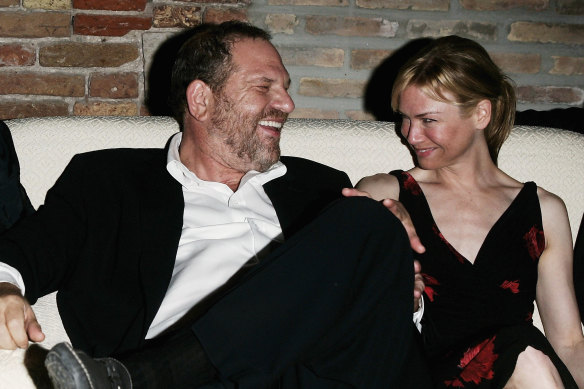
Renée Zellweger with the now-disgraced Hollywood producer Harvey Weinstein at a party in 2005. Credit: Getty Images
And then there’s that other side of it: that I love male-female banter, that playful dynamic. So, it’s a big conversation. I’m sure that I was on the receiving end of something that I don’t even know about, in conversations that I wasn’t privy to. But it wasn’t something that I felt, it wasn’t something that I was aware of. I was very surprised by some of the things that were unearthed. I didn’t know.”
I tell her that people have been surprised to hear that I didn’t know, either, having written about and been around so many people in Weinstein’s world. “But were you really around?” she says. “I wasn’t around it. I don’t hang out like that. I don’t go to the party. It’s part of my work: there’s a premiere, there’s an event, there’s a red carpet, there’s the hotel-lobby dinner. That’s my relationship to Hollywood. I don’t live in that. That’s my job. I visit it.”
But then she says this about the whole awful season of the Weinstein revelations, one after another, right on the cusp of Hillary Clinton being beaten by Donald Trump: “It was a very hard thing to hear about. And it was hard to accept the surprise of that. And I’m sorry that it’s hard to talk about, because this is a person that I did not know well, but I thought I knew him as I knew him. It was red carpets and a hotel lobby in passing or ‘I’ll see you at this after-party’ and ‘I’ll be there to make sure you go to promote our movie’ and ‘I’ll see you at Cannes’ or ‘I’ll see you at the French premiere’ or ‘I’ll see you in the editing room so we can pick these things apart’. And that’s a lot, when you talk about how we worked during that decade and a half …” She trails off and then worries that she’s said too much.
Sometimes, Zellweger can’t help herself – she just wants to talk. Way back in 2004, she was the first person I interviewed who cut out all the middle people and just gave me her phone number and email address. We stayed in touch for a few years and hung out at some parties; she would often text me out of the blue, just as she was landing in this or that city.
Back in Topanga, it’s approaching 7pm and still hot. Zellweger has to drive to pick up her dogs, who stay with her vet-tech friend DeAnn when she’s out of town. We pile into her black Jeep so she can drive me back to my hotel in Beverly Hills and then shove on down into the desert. But first she’s got to back out onto Topanga Canyon Boulevard in peak-hour traffic. She’s got the Beatles on the stereo (“I listen to the Beatles every day. Don’t you?”) and she’s inching out onto the shoulder, looking left, then right, then left again, waiting for an opening.
“That’s me,” she says, pointing out her road. “I live way over that ridge. Way over.” What made her buy this particular house? “Location. It feels a little bit like West Texas. It’s really remote. I like that it’s solitude and silence. There’s no mobile service up there, so there’s a different kind of peace that you don’t know you’re missing.” Earlier, we’d gotten into a conversation about the fact that we were both raised by practical fathers, men who liked to tinker and fix things, who taught us how to build a fence and change the carburettor on a Dodge Dart.
“The things that our fathers nurtured in us seem to matter up there,” she says, gesturing toward the ridge. “I have to clean up messes and solve problems. I have to deal with the generator and the septic system and the water tank.” The Oscar Zellweger won for Cold Mountain was for playing Ruby, a tough, capable country girl who taught Nicole Kidman how to build fences, how to snap a chicken’s neck and cook it for dinner. Strangely enough, that character is much closer to Zellweger than those dizzy, solipsistic Bridget Jones types.
When the apocalypse comes – when a real fire rears up and burns everything down – I hope I’m with Renée Zellweger, siphoning petrol out of cars and eating candy bars to stay alive – trying to figure out how to start over.
Correction: An earlier version of this article incorrectly stated that Judy Garland was married to Mickey Rooney. It was Mickey Deans. The error was made in the production process.
Edited extract of a story that first appeared in New York magazine. © New York magazine
To read more from Good Weekend magazine, visit our page at The Sydney Morning Herald, The Age and Brisbane Times.